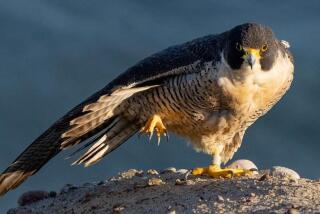3 Condors Captured, Taken to L.A. Zoo
Three California condors were captured in the mountainous Ventura County backcountry Tuesday and trucked to the Los Angeles Zoo, where they will live out their remaining years in the captive condor breeding program.
The birds, which had not eaten since March 14, eagerly attacked a calf carcass that biologists set out for them, officials said. Then, while the condors’ heads were in the carcass, biologists who had been hiding in the surrounding brush since daybreak fired cannons that shot a huge net over the birds.
“We hate to bring the birds in,” said Robert Mesta, coordinator for the U.S. Fish and Wildlife Condor Recovery Program. “But at the same time, we’re all relieved to have them out of there. They were spending too much time on the power lines” that killed three of the birds last year. Another condor died after drinking antifreeze.
The three birds, which now weigh 16 to 17 pounds and have wingspans of nine feet, were placed in individual flight kennels and taken by truck back to the zoo where they were hatched about 30 months ago.
It was an ignoble ending to the days of free flying in the wild for the three birds that were transported to the Sespe Condor Sanctuary by helicopter amid fanfare on Oct. 19, 1992, and released two months later.
But the public must be patient with scientists working in uncharted territory to bring the giant vultures back from the edge of extinction, said Randall Snodgrass, director of the endangered species campaign for the National Audubon Society.
“It took mankind more than 100 years to endanger these birds and we won’t be able to recover them overnight,” Snodgrass said. “Our society, our country owes it to these birds to at least try to bring them back.”
The capture of the three birds leaves six endangered California condors still in the wild in a remote section of the Los Padres National Forest in Santa Barbara County about 35 miles north of Ojai. Those six--five 1-year-old birds and one 3-year-old bird--are doing well in that location, learning to fly and forage in the wild, said Marc M. Weitzel, project leader for the Condor Recovery Team.
At least five or six more birds will be released into the wild late this year, Weitzel said. In addition, it is possible that the three captured birds, which each represent distinctive genetic lines, will be replaced with birds of like lineage.
Condors, which once roamed the skies of North America by the thousands, were down to 22 or 23 birds in 1983. The last wild bird was captured in 1987 and has since become part of the captive breeding program at the Los Angeles and San Diego zoos and a third facility in Boise, Ida.
Including the three birds captured, the six still in the wild and a hatchling that emerged from its shell on Monday, there are now 81 California condors in the world, said Mike Wallace, curator of conservation and science at the Los Angeles Zoo.
He said veterinarians at the zoo rearranged schedules to be ready to examine the three returning birds.
“We’re ready for them,” he said. “We’ll move them into isolation for a few days and let them settle down and relax” before full medical examinations, he said. The birds, which should weigh about 20 pounds, were also fed again because the stress of the capture made them vomit the meal they were devouring when captured, he said.
The Sespe Condor Sanctuary in Ventura County was the original site for the release of the first two condors in January, 1992. One of the two died in October that year after eating antifreeze. Six more were released that December, including the three captured Tuesday.
But three of those six died over the next year in collisions with power poles and from electrocution from power lines. Last November, in an attempt to move the curious birds away from hazards like power poles and other trappings of civilization, scientists captured the remaining four birds and moved them to the Lion Canyon area. Five chicks joined them there on a rocky outcropping that overlooks the rural Cuyama Valley.
The oldest of the four Sespe birds, Xewe, has remained at the remote Lion Canyon site with the five younger birds and is helping them learn to forage.
But the three other Sespe birds returned to their first home in the Sespe on March 14, and despite a lack of food refused to leave. Scientists decided to trap them and return them to the zoo rather than leave them to die of starvation or accident in the Sespe.
“They will be of much more use in a captive breeding program than they would be lying dead under some power pole,” Snodgrass said.
Weitzel said the capture is not a setback to the 12-year, $15-million effort to reintroduce the endangered California condor to the wild.
“It’s just part of the process,” he said.
More to Read
Sign up for Essential California
The most important California stories and recommendations in your inbox every morning.
You may occasionally receive promotional content from the Los Angeles Times.










